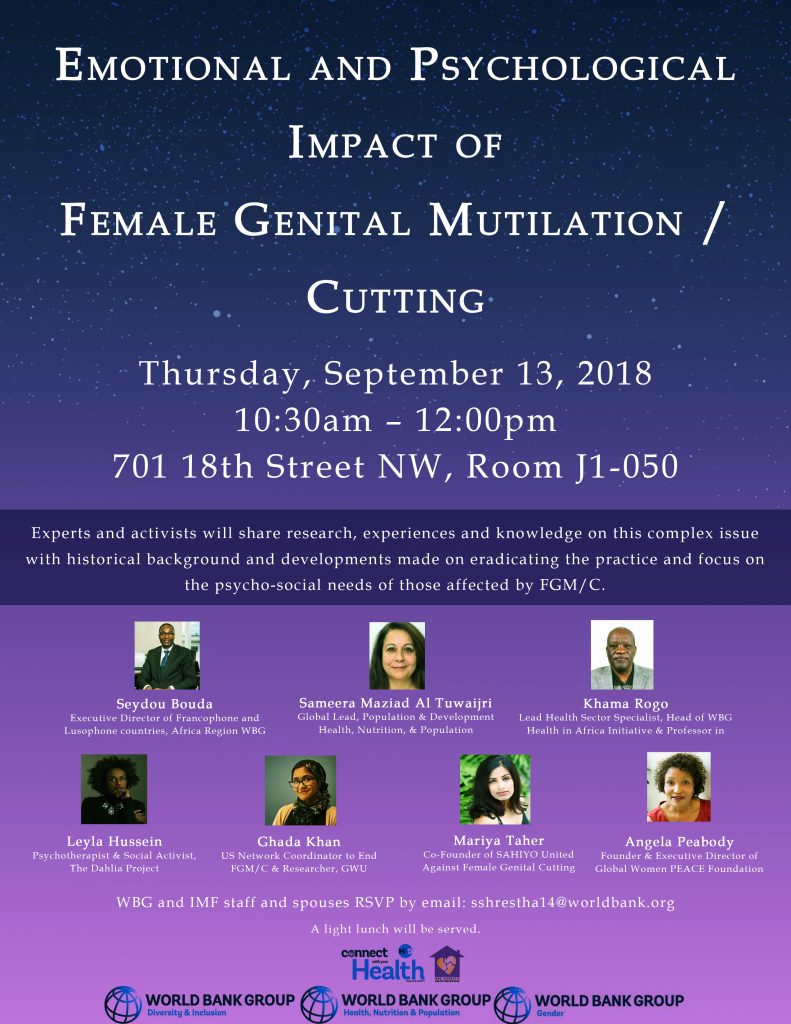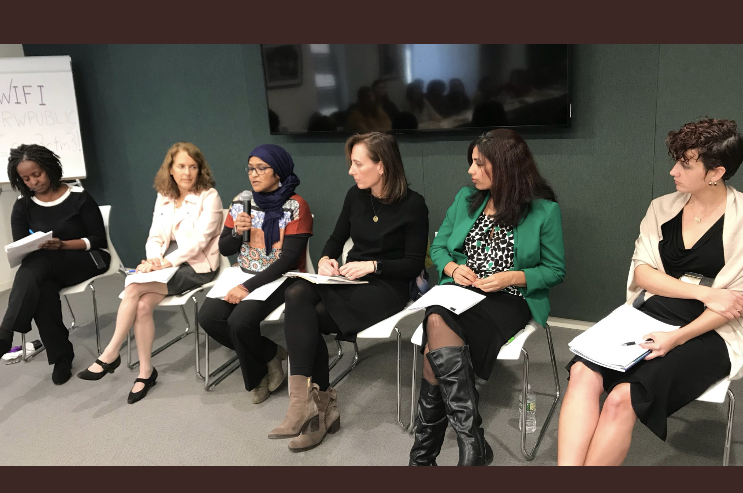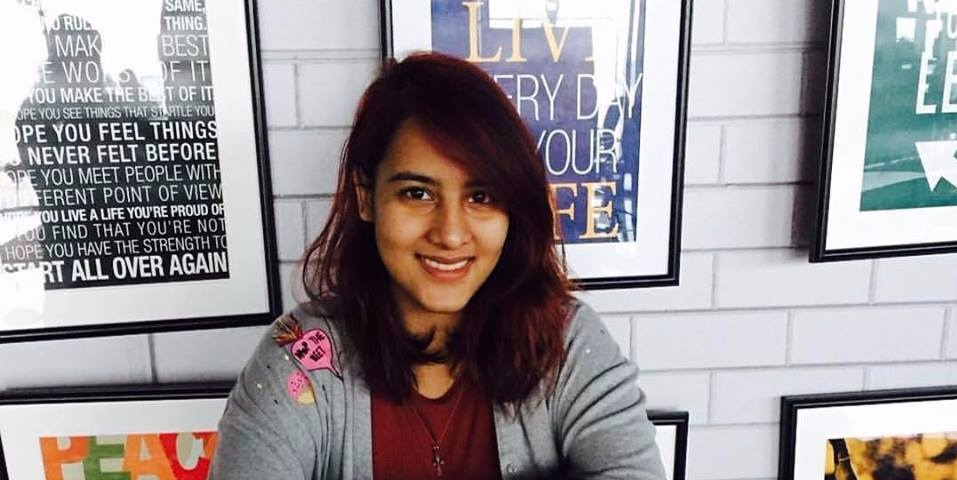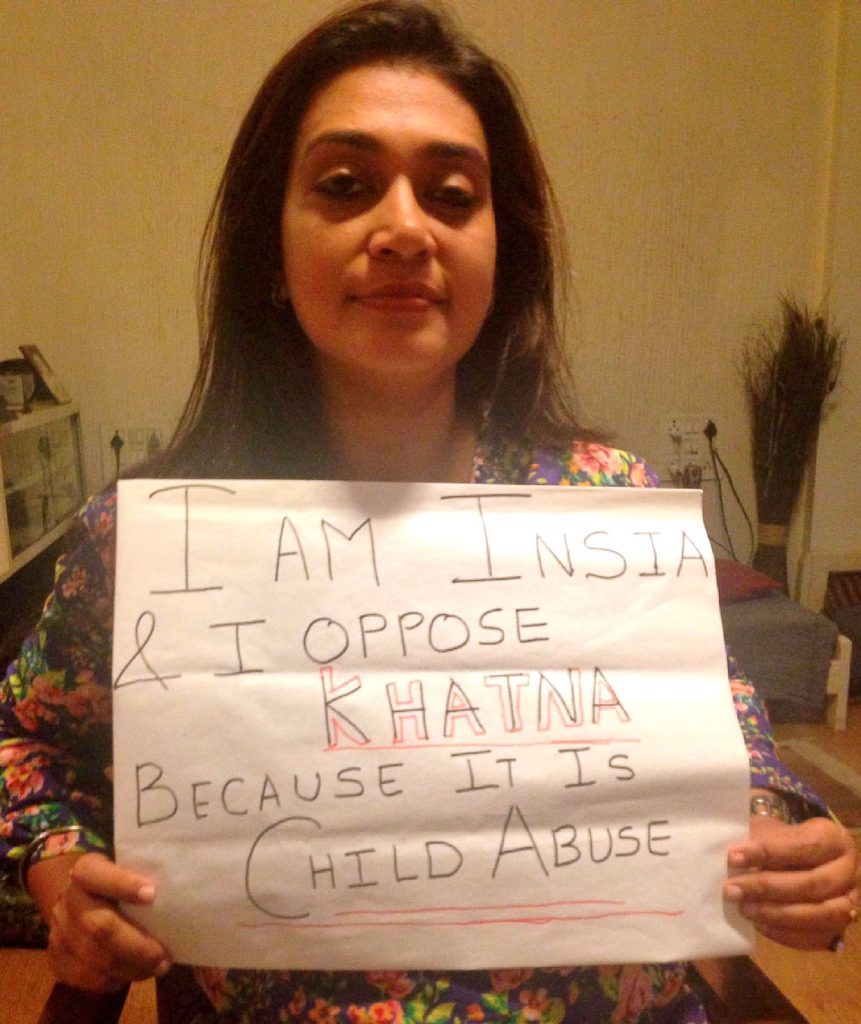World Bank Group hosts an informative workshop on FGM/C

On September 13, the World Bank Group hosted an informative workshop titled, “Emotional and Psychological Impact of Female Genital Mutilation/Cutting.” Experts and activists shared their research, experiences, and approaches used to address FGM/C. The workshop also focused on a discussion around meeting the psychosocial needs of those affected by FGM/C. Speakers included Leyla Hussein (keynote speaker), Mariya Taher, Ghada Khan, Angela Peabody, Seydou Bouda, Sameera Maziad Al Tuwaijri, and Khama Rogo.
Feeling drained after talking about Khatna? Here are some resources that can help

By Priya Ahluwalia Priya is a 22-year-old clinical psychology student at Tata Institute of Social Sciences – Mumbai. She is passionate about mental health, photography and writing. She is currently conducting a research on the individual experience of Khatna and its effects. Read her other articles in this series – Khatna Research in Mumbai. As human beings we are trained to react immediately, lessen the magnitude of pain when injured, manage our emotions when overwhelmed. We always initiate a response, however not all actions can be immediately responded to, especially when they are extremely distressing or traumatic. Often they are hidden away by our minds to prevent any major upheaval for us. However, even when hidden, they tend to seep through the cracks, leading to subtle effects such as difficulty falling asleep, distrustfulness, self doubt, among others. But sometimes, a small object, event or even a word can widen the crack, leading to a dam of emotions running out. This process is called re-traumatization. Perhaps the best description of the same would be an object, event or situation which leads to re-experiencing the emotions and physical symptoms that are associated with the initial episode of trauma. It is essential to acknowledge that all individuals give a similar physical response to trauma, but the psychological response is never the same. For example, we are biologically programmed to give a physical response to pain, such as crying when injured. However, we are culturally conditioned to suppress the psychological pain caused by the injury, which is essentially the case with women who have undergone FGC/Khatna. Although the pain is suppressed, it cannot be avoided because it begins to manifest indirectly. For example, one of the participants, I interviewed for my research reported that although she does not remember anything from the day of her Khatna, she has been terrified of blades ever since then. This is a clear example of unaddressed psychological distress. Thus, irrespective of whether the response to trauma is immediate, delayed, drastic or subtle, all individuals must gain access to resources for assistance. Therefore, while delving into a topic such as Khatna, which is emotionally charged and traumatic, it is the researcher’s responsibility to ensure that the effect of re-traumatization is minimized. As cliché as it sounds, listening is perhaps the best therapeutic tool to minimize re-traumatization. Case studies have shown that when victims of trauma are unheard they are more likely to indulge in self-destructive behaviour. Besides listening, providing an open and safe environment, choices, lists of resources and being available post the interview are also known to help. However, it is essential that a sense of independence be encouraged. Therefore survivors must be trained to look out for signs on their own and have a some set of immediate resources be available for themselves. Some of the signs to look out for: Sudden and recurring thoughts of an unpleasant event, that may be difficult to control. Change in sleeping habits: an increase or decrease in the need for sleep, as compared to before the interview with the researcher. Change in eating habits: an increase or decrease in appetite as compared to before the interview with the researcher. Difficulty paying attention to an activity at hand, inability to remember information. Easily irritated. Not interested in participating in activities which were earlier enjoyable. Frequent crying spells. Using negative statements (“I am bad”) while addressing oneself. Having extremely negative view of the world (“everyone in the world is bad”). Regular thoughts of death or harming oneself. Distrust and suspiciousness of those around oneself. Sense of powerlessness Increased feeling of fear Things to do: Seek out a trusted confidante and talk to them, it will allow you an emotional release as well as provide the support to overcome the current distress you feel. Arrange your day in a way that allows for at least 1 or 2 activities, such as painting or dancing among others, which give you positive emotions such as happiness. These activities could last from anywhere between 30 minutes to an hour, preferably not consecutively organised. Seek out support in organizations – research has shown that women who choose to speak out about their trauma by joining organizations working against the trauma that they survived are more adept with dealing with their emotions as they are able to gather wider support of individuals with similar experiences. Perform physical activity which would allow your body to release positive hormones which would assist in overcoming some of the negative emotions you may currently feel. Progressive Muscle Relaxation: Progressive muscle relaxation is a two-step process in which you systematically tense and relax different muscle groups in the body. With regular practice, it gives you an intimate familiarity with what tension—as well as complete relaxation—feels like in different parts of the body. This can help you to you react to the first signs of the muscular tension that accompanies stress. And as your body relaxes, so will your mind. Steps involved: Start at your feet and work your way up to your face, trying to only tense those muscles intended. Loosen clothing, take off your shoes, and get comfortable. Take a few minutes to breathe in and out in slow, deep breaths. When you’re ready, shift your attention to your right foot. Take a moment to focus on the way it feels. Slowly tense the muscles in your right foot, squeezing as tightly as you can. Hold for a count of 10. Relax your foot. Focus on the tension flowing away and how your foot feels as it becomes limp and loose. Stay in this relaxed state for a moment, breathing deeply and slowly. Shift your attention to your left foot. Follow the same sequence of muscle tension and release. Move slowly up through your body, contracting and relaxing the different muscle groups. It may take some practice at first, but try not to tense muscles other than those intended. 6. Mindfulness Meditation: Rather than worrying about the future or dwelling on
Asking more questions is the key to change, and to ending Female Genital Cutting

By Priya Ahluwalia Priya is a 22-year-old clinical psychology student at Tata Institute of Social Sciences – Mumbai. She is passionate about mental health, photography and writing. She is currently conducting a research on the individual experience of Khatna and its effects. Read her other articles in this series – Khatna Research in Mumbai Flexibility is a key characteristic of successful research, and it is an extremely essential component of the questions on which the research is based. Although I believe that having an exhaustive list of questions pre-prepared is essential to keep one on track, however as one reads and interacts with others, newer lines of enquiry are generated. It is crucial that all lines of enquiry be amalgamated to allow for a wholesome insight into one individual’s experience. Currently my interactions with women allowed me to see connections in their narratives. Accompanied by the literature I read, I found similarities as well as differences in the narratives of women across the world. Researchers have found that Female Genital Cutting (Khatna) leads to urinary problems, menstrual problems, problems in sexual functioning and difficulties during childbirth; some have even found that the psychological distress of the trauma often leads to depression and anxiety among women. A common pattern I found among studies was that all mental distress experienced by women was studied as a didactic relationship, ie, the women in relation to another individual. For example, sexual difficulties leading to marital distress among husband and wife. However it was intriguing that in my interactions with women I found that Khatna has a great impact on the women’s relationship with themselves. For example, a participant reported that she dealt with self-esteem issues because she felt out of place while growing up, as she did not have the same sexual impulses towards boys as her other friends, the lack of which she attributed to Khatna. My area of interest was always the psycho-social effect of Khatna. However, now I am more curious than ever to explore how Khatna impacts both women’s social relationships as well as their relationship with themselves. Little research has been done to explore how an individual’s worldview (ie, understanding of the world and how it functions) shifts after their discovery and understanding of Khatna. My curiosity in this area was ignited when one woman reported that following her discovery of Khatna, she was extremely angry with her family and although she has now made peace with her family, her trust in them and her faith in people’s ability to make good decisions has been shattered. I am now fascinated to interview more women and see how their worldview might have shifted after their discovery of Khatna. Furthermore, research in attitude formation shows that negative experiences with one aspect of a larger domain leads to a negative attitude towards all aspects of the domain. If the same was extended to the practice of Khatna rooted in religious obligation, it would be interesting to explore how attitudes towards Khatna and religion are interlinked. With each conversation, the questions in my mind multiply and it is often followed by a sense of hesitation of being overambitious. However, I do not let the hesitation pull me back, and the credit for that goes to one research participant who told me that if someone before us had asked these questions, then we wouldn’t have to be here today, and unless we ask these questions, nothing will change and we will still be here five years down the line. I have made a decision to change, have you? To participate in Priya’s research, contact her on priya.tiss.2018@gmail.com
A conversation with change makers: women who chose to speak up about Khatna

By Priya Ahluwalia Priya is a 22-year-old clinical psychology student at Tata Institute of Social Sciences – Mumbai. She is passionate about mental health, photography and writing. She is currently conducting a research on the individual experience of Khatna and its effects. To read Priya’s first blog in this series, visit ‘How I found out Khatna exists and why I choose to speak out’. The first time I heard the statement,“Well it could have been you! It could have been anyone! But it happened to me,” by a woman who had gone through khatna, I felt its weight immensely on me. I do not yet have the answers for why this statement affected me so intensely, but it has strengthened my resolve to understand and generate more awareness about Khatna, because it has affected women for so long and has the capacity to affect many more. The first step in my research journey is to talk to women who have been directly affected by Khatna. While deciding upon the questions to ask my participants, my number one concern was to not sound insensitive or biased when asking them about Khatna. More importantly, I wondered how to ask questions about something this personal without sounding intrusive. The sensitivity of the questions depends on the context in which you ask the question rather than how you frame it, whereas the intrusiveness of it depends on the reactions from the women. It was interesting for me to observe that none of the women found the questions to be intrusive or uncomfortable, rather there was a normalized, patterned response given from them, as if these were routine questions. My early hypothesis was that women would feel overwhelmed while responding to these questions, but that is not what I found. There are two possible reasons for this: one, they have been asked these questions before and thus have already reflected on the questions and know the answers for themselves; two, by choosing to speak about Khatna, they have already begun their healing process and by normalizing speaking about the incident they perhaps have taken back a sense of control that they had lost when they underwent it. Future interactions with more women will allow me to formulate a definite conclusion. It was fascinating to observe that although each woman had an individual experience of Khatna, their stories were eerily similar and the trajectory of growing up and figuring out the significance of it was uncannily alike. A lot of the women I interviewed had repressed their memory of the day of their Khatna, and they grew up without any conscious knowledge of what had happened or what it meant, only to discover its significance much later in life. However, perhaps their discovery of Khatna later in life comes due to the ripple effect created by one woman speaking out. The women I have spoken with have talked about how hearing how other women were speaking about their experiences helped them to remember their own experience of Khatna. While interviewing women, some common traits I found among the respondents were curiosity, a fierce need for answers and an extraordinary amount of courage. All the women I interviewed had an aura of strength around them which was empowering. It crushed the fear and hesitancy I had in asking the questions, and it empowered me to not only raise more questions about Khatna. Through reflection, I found that change happens through empowering conversations. While doing this research, always at the back of my mind, has been the questions of “Who are the changemakers?” I recognized that change-makers are those who have the courage to question the law of the land, who show resilience in the face of daunting challenges and who empower others to fuel the fire of change. These women have empowered me to continue the change, and I request you to join me in further promoting this change. If we do not speak out, then who will? To participate in Priya’s research, contact her on priya.tiss.2018@gmail.com
How I found out Khatna exists and why I choose to speak out

By Priya Ahluwalia Snugly sitting on my bed on the wintry night of December, a cold chill ran down my spine as I read through the Change.Org petition against Female Genital Mutilation also known as Female Genital Cutting or Khafz. I failed to recognize the magnitude of this practice because of the lack of knowledge of my own genitalia, but reading the petition created dread in my mind. The dread transformed into anger, anger towards the society that violated its own daughters, anger towards all those who let the practice continue and anger towards the ignorance of my own immunity. In anger I signed the petition but it was the vicarious traumatisation I went through while reading the petition in the first place that made me speak out. An implicit responsibility of those choosing to speak out is to create more awareness. However, to my amazement I found that despite the multitudes of women affected by it, the information on FGC was little. Therefore I never understood the true roots of the practice and its implications on the community until this February at Sahiyo’s activists retreat in Mumbai. The retreat was perhaps the most comprehensive and genuine source of information about the Bohra community, the practice of Khafz and its implications. The retreat was also responsible for breaking one of the biggest barriers I had while talking about this practice: intellectualization. I had honed the tendency to talk about FGC mechanically, removing all speck of emotion from my voice as a way of protecting myself from further distress and also to prevent any secondary opinions or personal bias colouring my narrative. However emotions are fundamental to those who choose to speak out including myself, and therefore ignoring them would be a grave injustice to us all. A one-toned discussion has never led to any change, therefore it is integral that while holding a discourse on Khatna, the emotions be incorporated within the facts. While presenting FGC as a topic in my school and college years, I often noticed the discomfort that many people feel as soon as the term genitalia was introduced. I couldn’t help but wonder that if verbalizing the word caused so much distress to an adult, then imagine the fear felt by the seven-year-old girl whose legs were held apart and her rights stolen away. I can feel the anguish, I can feel the anger and I can feel the betrayal she must have felt, because I could have easily been that girl, but here is where my immunity lies; I come from a community where this form of gender violence does not exist. However, the immune must support raising those who have undergone FGC which is why I chose this as a topic for my master’s thesis. This was not a decision I took lightly or quickly, because I know the responsibility that lies with me. I had felt reluctance because I wondered if I, an outsider with little understanding of the community and the practice, would be able to do justice to the women and their stories. I do not know how the thesis will turn out but I know that I will do my best to do right by the women who choose to speak to me. They will not be just data but people with stories to tell that need to be protected and preserved. My aim is to understand the practice as a whole and therefore, I do not want to have a hypothesis of the results I will get, rather I wish to incorporate in my research as many voices as I can, both those who are pro-khatna and those who oppose it. My job as a researcher will be to be open to all narratives and record them as authentically as I can. All of us have a voice and therefore have the responsibility to use it wisely. Thus, I choose to use my voice for myself and all those women who have been silenced under the burden of tradition. (Priya Ahluwalia is a 22-year-old clinical psychology student at Tata Institute of Social Sciences – Mumbai. She is passionate about mental health, photography and writing. To participate in her research, contact her on priya.tiss.2018@gmail.com )
DC Meeting- Expert Consultation on FGC and Mental Health

On Feb 27th, Sahiyo’s Mariya Taher attended a roundtable discussion in DC on FGC and Mental Health hosted by the Wallace Global Fund and the International Center for Research on Women (ICRW) Although the global development community has increasingly acknowledged the adverse physical health complications that can result from FGC, there has been little action to address its psychological impact. The roundtable served as a first step to bring together experts from bilateral and multilateral agencies, donor institutions, academia, policy-makers, civil society and program implementing organizations in the United States to gain a better understanding of FGC and mental health, as well as to drive a collaborative, coordinated and appropriately sized response across the globe. Throughout the day, the panelists and attendees discussed the short and long-term mental health of survivors and activists who engage additional barriers when advocating to end FGC. In addition, dialogue about research needs, support programs, and prevention in connection with mental health occurred. Mariya served on a panel to discuss the findings of Sahiyo’s Needs Assessment. Sahiyo had recently partnered with a healthcare market research consultancy to conduct primary market research with activists speaking out against FGC, in an effort to better understand activists’ challenges and hopes for the future.To learn more about this research, visit Sahiyo’s website.
Trauma and Female Genital Cutting, Part 1: What is trauma?

(This article is Part one of a seven-part series on trauma related to FGC. This article should not be used in lieu of seeking professional mental health and counseling services when needed) By Joanna Vergoth, LCSW, NCPsyA Many women who have undergone FGC may not have any lasting disturbances. But based on the Sahiyo study alone (see pie-chart below), there are those who may benefit from a deeper understanding of the effects of trauma. Often, we minimize, dismiss or normalize our symptoms and resign ourselves to feeling/living compromised. Learning more about trauma can provoke conversation; help one to feel less isolated and can prompt one to seek professional help. What is trauma? A traumatic event is defined as direct or indirect exposure to actual or threatened death, serious injury or sexual violence. The incident may be something that threatens the person’s life or safety, or the life of someone close to the victim. Traumatic incidents can include kidnapping, serious accidents such as car or train wrecks, natural disasters such as floods or earthquakes, or violent attacks such as rape, sexual or physical abuse, or FGC. As defined—although culturally sanctioned— FGC is a traumatic event (see chart from Sahiyo’s study below). Although for some the consequences can be minimal, most of the evidence suggests that FGC is extremely traumatic and the physical or medical complications associated with FGC may remain acute or chronic. Early, life-threatening risks include hemorrhage, shock secondary to blood loss or pain, local infection and failure to heal, septicemia, tetanus, trauma to adjacent structures, and urinary retention. One of the more frequent longer-term medical consequences includes adhesions or scarring, which can contribute to lingering pain and impede sexual functioning. The focus of FGC has long been regarded from a physical and medical perspective but it is equally important to consider the psychological and emotional implications of this practice. It has been reported that the psychological trauma that women experience through FGM ‘often stays with them for the rest of their lives’ (Equality Now and City University London, 2014, p.8). Sahiyo’s study found that of the 309 participants in the study who had undergone FGC in the Dawoodi Bohra community, almost half (48%) reported that the practice left a negative emotional impact on their adult life. Usually, the girl, unprepared for what is about to happen, is taken by surprise and cannot prevent what is about to occur. Those that can remember the ‘day they were cut’ often report having initially felt intense fear, confusion, helplessness, pain, horror, terror, humiliation, and betrayal. Many have suffered a multi-phase trauma; the first being forced down and cut and then second is seeing or hearing another family member endure the procedure. Even anticipating the procedure, oneself can be terrifying. Also of significance is the community and family reaction to the painful reactions experienced by these young women. Often girls can be chided for crying and not being brave while undergoing the cutting. This dismissive, non-nurturing reaction can potentially lead to another facet of the multi-phase trauma. Some proponents of FGC actually consider that the shock and trauma of the surgery may contribute to the behavior described as calmer and docile—considered to be positive feminine traits. FGC is a traumatic event that can profoundly rupture an individual’s sense of self, safety, ability to trust and feel connected to others—aspects of life considered fundamental to well-being. Such genital violence can interrupt the process of developing positive self-esteem. And, when children are violated their boundaries are ruptured leading to feelings of powerlessness and loss of control. Children who have experienced trauma often have difficulty identifying, expressing and managing emotions, and may have limited language for describing their feelings and as a result, they may experience significant depression, anxiety or anger. Over time, if the distress can be communicated to people who care about the traumatized individual and these caretakers respond adequately, most people can recover from the traumatic event. But, some FGC affected girls and women experience severe distress for months or even years later. The symptoms of trauma: Outlined below are some of the consequences that may occur following a traumatic event. Sometimes these responses can be delayed, for months or even years after the event. Often, people do not even initially associate their symptoms with the precipitating trauma. Physical Eating disturbances (more or less than usual) Sleep disturbances (more or less than usual) Sexual dysfunction Low energy Chronic, unexplained pain Emotional/behavioral Depression, spontaneous crying, despair, and hopelessness Anxiety; feeling out of control Panic attacks Fearfulness Feelings of ineffectiveness, shame, despair, hopelessness Irritability, anger, and resentment Emotional numbness Withdrawal from normal routine and relationships Feeling frequently threatened Feeling damaged Self-destructive and impulsive behaviors Sexual problems Cognitive Memory lapses, especially about the trauma Difficulty making decisions Loss of previously sustained beliefs Decreased ability to concentrate Feeling distracted Over time, even without professional treatment, traumatic symptoms generally subside, and normal daily functioning gradually returns. However, even after time has passed, sometimes the symptoms don’t go away. Or they may appear to be gone, but surface again in another stressful situation. When a person’s daily life functioning or life choices continue to be affected, a post-traumatic stress disorder (PTSD) may be the problem, requiring professional assistance. To learn more about PTSD, see our Part II – Post Traumatic Stress Disorder About the Author: Joanna Vergoth is a psychotherapist in private practice specializing in trauma. Throughout the past 15 years she has become a committed activist in the cause of FGC, first as Coordinator of the Midwest Network on Female Genital Cutting, and most recently with the creation of forma, a charity organization dedicated to providing comprehensive, culturally-sensitive clinical services to women affected by FGC, and also offering psychoeducational outreach, advocacy and awareness training to hospitals, social service agencies, universities and the community at large.
‘I feel dirty and violated’: A Bohra survivor of Female Genital Cutting shares her story

By Shaima Bohari Age: 21 Country: India I don’t remember how old I was. I remember just that I was a very young girl. My family and I were vacationing in Indore, Madhya Pradesh, in a small house not far from my maternal grandmother’s in Noorani Nagar. My mother called me, told me to change and said my grandmother was going to take me out for a little while. Me being the weird kid I was, I got excited. So we set out, my nani and I, on a little walk around the block. She explained to me that we were going to see an older lady who was going to help me with something that was for my own benefit. When we reached the house, my nani talked to this lady and introduced me to her. We went into a room in the back where three other older ladies were present. I was told to remove my pants and lie down on a mat laid out on the floor. I felt afraid and naked and my nani told me to just relax and held my hand. The women around me held down my arms and legs, keeping my legs apart. The lady of the house came in with something sharp in one hand and a cloth in the other, and she knelt down beside my legs. She used something like a glass to make a small cut and then pinched something near my vagina. I vividly remember screaming my lungs out and hitting and punching whoever was near my hands, flailing around like I was possessed. It was a short ordeal but it felt like hours had gone by since I’d left the house. I was told to get up and get dressed. As far as I can remember I wasn’t bandaged or covered with anything but the clothes that I came with. My nani gave me an envelope with some money and asked me to give it as salam to the lady who had mutilated me just minutes before. I was crying even as I kissed her hand and then left with my nani for the walk back, in my blood-stained clothes. After we came home, my mom laid me down on the bed on a set of sheets. Again I was naked from the waist down, and was told to stay there until the bleeding had stopped. I pushed that memory down and out, or at least I tried to. I could never really forget it though, and now I’m not sure I want to. It was a barbaric and horrible event that I had to go through, but I don’t want to repress it because clearly, that hasn’t worked until now. I suffer from a myriad problems because of that one incident in my life. I still don’t know how to deal with it. I suffer from pain in my vagina, I can’t look at myself naked, I have self-esteem and body issues because every time I look at myself I feel dirty and violated. I doubt I will ever be able to have a relationship with my future spouse if I decide to get married because I can’t imagine it. I suffer from severe depression which, at least partly, stems from this. To all the men who have the audacity to tell me that this barbaric mutilation of the female form is inconsequential and alright because it is a religious act: it’s easy for you to say this since you haven’t gone through the trauma. Also as we all know, this systematic, brainwashing and torturing of women is a weapon in your hands. To all the women who defend female genital mutilation, I want you to know that you are an insult and a curse to all the women who have suffered from the traumas of FGM, and it is YOU who make it okay for men to abuse us. You give them the power to mutilate and oppress us when you stand against other women. Although I cannot speak for any higher power out there, you will find no forgiveness from me. I also want to point out that although I do blame my grandmother, and my mother, and every member of my family who didn’t stop them, and those who let their own daughters, nieces, cousins, and granddaughters be mutilated, I understand that the majority of the blame lies with the institution that made them believe that this is righteous. Finally, I ask anyone who reads this to talk to any woman you know about this. Tell them they’re not alone, and that it doesn’t make them any less of a human for having gone through this. Talk to other people, raise awareness about this inhuman practice, so that it is no longer a taboo topic. So that women everywhere are able to open up about their horrific past and know it wasn’t their fault.
The story of my start to the holy month of Ramzan

by Insia Dariwala, Sahiyo Ramzan — the time of peace, love, and prayers; a time for family gatherings, breaking fasts together and collectively praying for individual good, and the good of all in this world. Unfortunately, this Ramzan is showing me exactly the opposite, as I see the entire Bohra community (well almost), rising up to bring us down, in the guise of reinstating religious freedom. Over the past few days, as this circus on social media unveiled, I have been inundated with text messages, phone calls and emails about how Sahiyo is being talked about at every community gathering. We are being called names, our personal lives are being attacked, our religious loyalties are being questioned, and anyone who speaks for us is being targeted with a lot of viciousness. Many of those who speak for us have come back to us feeling saddened and helpless. Helpless because they want to stand up to the bullying, but are very afraid of the verbal attacks on their parents, on their relatives, and other family members. They are afraid of the humiliation, of the subtle ostracism, and the backlash from their jamaats, so they choose to stay anonymous. Anonymity has its own comfort. It allows you to speak up. It allows you to have a voice, and that’s exactly why we have so many girls and women who have chosen to let go of their right to be visible, only to stand up against this practice. They choose to live the duality of having a voice, and yet pretend they are voiceless, because that is the only way they will be accepted into the fold. For these very reasons, when I am asked why I, or my other Sahiyo girls, are not responding to the ‘Sahiyo is not my voice’ campaign against us, my answer to them is very simple — we never ever claimed to be anyone’s voice. We just made space for the women who wanted to have a voice. Why then are all these people feeling so threatened? It amuses me to see how a few voices of dissent could become such a big threat to an entire community. I am also amused to see the kind of efforts put into creating content to beat us up, acquiring social media handles, blocking our social media handles, and going to such great lengths to reinforce their identity. It’s sad to see how our attackers are just dismissing what so many women went through after they were cut. This backlash is exactly what prevents survivors of any trauma to share their stories. The pain endured may or may not have been the same for all, but the shame which they are being put through for speaking up about it, is the same. Unfortunately, it also reminds me of what so many survivors of domestic violence, child sexual abuse, and rape go through. It’s always the fault of the one who went through it. “She should have shut up.” “She should have been clothed more appropriately.” “She should have never disobeyed her husband.” And so the cacophony of society’s empty culture and tradition continues. Would it be safe to then say this has nothing to do with ours or anybody else’s religious beliefs? Would it also be safe to say that it’s disheartening to see, how an entire community’s faith rests on what’s cut between a girl’s legs? Is faith so weak, that it requires to be enforced through archaic and harmful traditions carried out thousands of years ago? Is it so weak that one needs to resort to bullying, and exploitation, in order to sustain its own existence? This message is for all the women who want this practice to continue — You can hate us all you want, and trick yourself into believing that you are doing this for your religion. But no religion practices hate. No religion asks you to put someone down to look good. No religion asks you to hurt, humiliate, threaten, and isolate someone who has a different point of view. Religion is what you ‘are’, not what you ‘pretend’ to be. It is about forgiveness, compassion, empathy, and the ability to reach out and accept. Today, as you pray while breaking your fast, do ask yourselves, Am I all of this? Then and only then, will it truly be the month of Ramzan.
